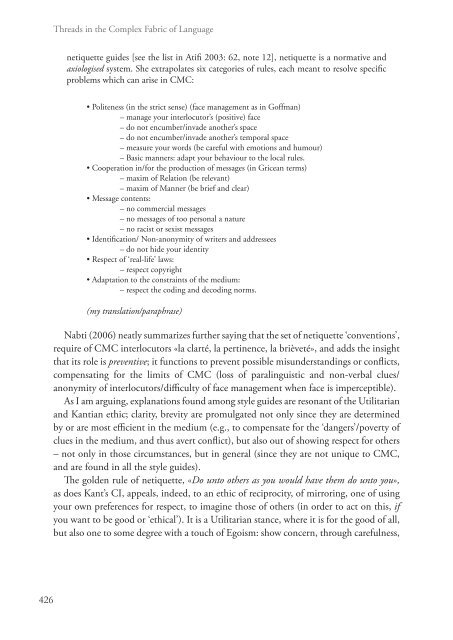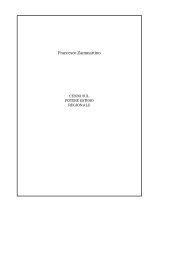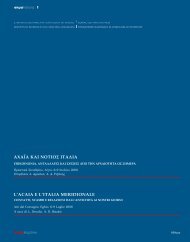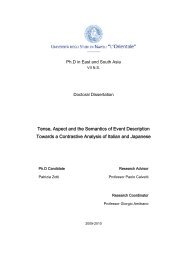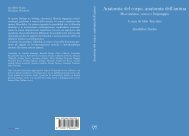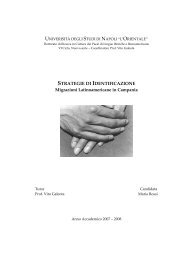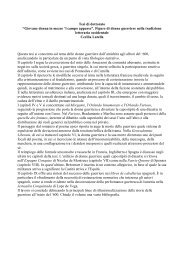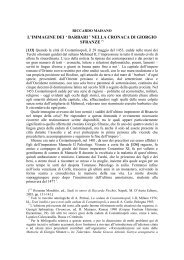Threads in the Complex Fabric of Languagenetiquette guides [see the list in Atifi 2003: 62, note 12], netiquette is a normative andaxiologised system. She extrapolates six categories of <strong>rules</strong>, each meant to resolve specificproblems which can arise in CMC:• Politeness (in the strict sense) (face management as in Goffman)– manage your interlocutor’s (positive) face– do not encumber/invade another’s space– do not encumber/invade another’s temporal space– measure your words (be careful with emotions and humour)– Basic manners: adapt your behaviour to the local <strong>rules</strong>.• Cooperation in/for the production of messages (in Gricean terms)– maxim of Relation (be relevant)– maxim of Manner (be brief and clear)• Message contents:– no commercial messages– no messages of too personal a nature– no racist or sexist messages• Identification/ Non-anonymity of writers and addressees– do not hide your identity• Respect of ‘real-life’ laws:– respect copyright• Adaptation to the constraints of the medium:– respect the coding and decoding norms.(my translation/paraphrase)Nabti (2006) neatly summarizes further saying that the set of netiquette ‘conventions’,require of CMC interlocutors «la clarté, la pertinence, la brièveté», and adds the insightthat its role is preventive; it functions to prevent possible misunderstandings or conflicts,compensating for the limits of CMC (loss of paralinguistic and non-verbal clues/anonymity of interlocutors/difficulty of face management when face is imperceptible).As I am arguing, explanations found among style guides are resonant of the Utilitarianand Kantian ethic; clarity, brevity are promulgated not only since they are determinedby or are most efficient in the medium (e.g., to compensate for the ‘dangers’/poverty ofclues in the medium, and thus avert conflict), but also out of showing respect for others– not only in those circumstances, but in general (since they are not unique to CMC,and are found in all the style guides).The golden rule of netiquette, «Do unto others as you would have them do unto you»,as does Kant’s CI, appeals, indeed, to an ethic of reciprocity, of mirroring, one of usingyour own preferences for respect, to imagine those of others (in order to act on this, ifyou want to be good or ‘ethical’). It is a Utilitarian stance, where it is for the good of all,but also one to some degree with a touch of Egoism: show concern, through carefulness,426
Vincent - <strong>Netiquette</strong> <strong>rules</strong>, <strong>OK</strong>! … <strong>OK</strong>?: Speculating on Rhetorical Cleansing...clarity, brevity, openness with information, respect for the other’s Autonomy; 25 showcooperation, politeness, respect for the other’s (mirrored preferences), because in the endit’s in your own good. An Individualist (whether of Triandis’ vertical or horizontal type)ethic of concern for other individuals, is, indeed, a reciprocal Rights, and Autonomytype of ethics. 264. Across languages and culturesWhat about the threat of cultural imperialism or rhetorical cleansing through theglobalisation of netiquette?Atifi (2003: 12-13), takes the tack (after his reporting of Marcoccia’s schema above)that netiquette defines «Anglo-Saxon» <strong>rules</strong> for global communication; transculturaland universal <strong>rules</strong> meant to be valid for all the «internautes du village planétaire»:Many aspects testify to this globalising assumption. On the one hand, the <strong>rules</strong> themselvesare seen as advice, or rather injunctions which must be followed in cyberspace. On theother, this [particular] netiquette, which is essentially, American, is the most imported,assimilated and reproduced, as is, by different website administrations world wide. Now,this is the most important point: these global <strong>rules</strong> define an ideal communicative styledetermined in part by specifically ‘Anglo-Saxon’ cultural traits. Thus, netiquette seems to us tobe actually a reflection of the North American communicative style, i.e., of the way in whichan individual from that culture presents himself and behaves in interaction (Blum-Kulka,House, Kasper 1989). Concretely, this universalist conversational ideal rests to somedegree on the [positive] value [judgment] (“valorisation”) of four behaviours which arecomparatively central to the North American communicative ethos: the search for consensus(as opposed to acceptance of conflict tolerated by other cultures), the control of emotions(as opposed to Mediterranean more expressiveness); conciseness of messages (as opposed toMediterranean volubility) and a preference for indirectness [sic] as opposed to directness[sic] tolerated in Arabic cultures. [my translation, and italics]We find here in a nutshell many points I am trying to speculate on. Atifi, however,then goes on to deny any stylistic colonisation in his Moroccan forums where localcultural ethos is, instead, strongly alive and well.This brings us conveniently to considering the cross-cultural aspect: how do interactantsfrom different cultures behave intra-culturally in CMC (and then, as a consequencepresumably, perhaps, inter-culturally)? And, are there signs of rhetorical colonisation?25 On the Kantian respect for Autonomy- right to information, as consideration for others, etc. – seediscussion in Vincent Marrelli (2004: 345)26 See, e.g., Vazquez et al. (2001) on types of morality systems; and Scollon and Scollon (1995) for theconnection between Individualism and Utilitarianism; but see Rooksby and Piggott (1997), Rooksby(2001), who argue for a non-Individualistic, non-Utilitarian view of the net.427
- Page 1: Netiquette rules, OK! … OK?: spec
- Page 6 and 7: Threads in the Complex Fabric of La
- Page 9 and 10: Vincent - Netiquette rules, OK! …
- Page 11 and 12: Vincent - Netiquette rules, OK! …
- Page 13 and 14: Vincent - Netiquette rules, OK! …
- Page 15 and 16: Vincent - Netiquette rules, OK! …
- Page 17: Vincent - Netiquette rules, OK! …
- Page 21 and 22: Vincent - Netiquette rules, OK! …
- Page 23 and 24: Vincent - Netiquette rules, OK! …
- Page 25 and 26: Vincent - Netiquette rules, OK! …
- Page 27 and 28: Vincent - Netiquette rules, OK! …
- Page 29 and 30: Vincent - Netiquette rules, OK! …
- Page 31 and 32: Vincent - Netiquette rules, OK! …
- Page 33 and 34: Vincent - Netiquette rules, OK! …
- Page 35: Vincent - Netiquette rules, OK! …


